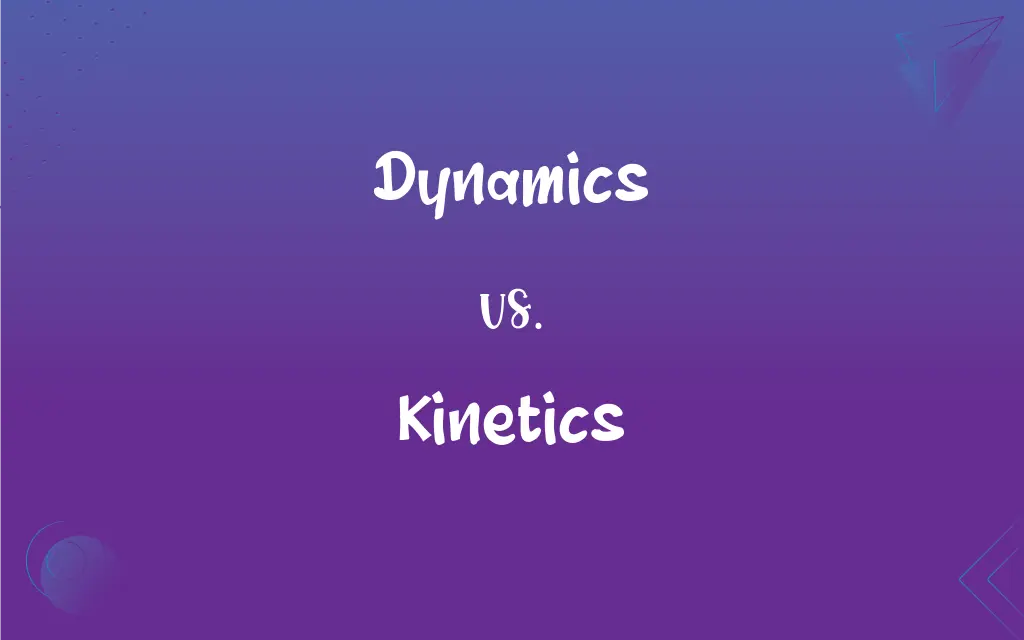Dynamics vs. Kinetics: What's the Difference?
Edited by Janet White || By Harlon Moss || Updated on November 2, 2023
Dynamics refers to the forces that cause motion in objects, whereas kinetics is the study of the rate of processes, like chemical reactions.

Key Differences
Dynamics is a branch of mechanics that deals with the forces and their effects on objects in motion. It encompasses the study of systems in motion and the factors that affect this motion, such as torque and friction. Kinetics, in contrast, is a term often used in chemistry and biochemistry to describe the speed at which chemical reactions occur and the factors that affect this speed, like temperature and concentration.
In dynamics, the focus is on how velocities change with time due to applied forces. This can apply to celestial bodies in astrophysics, vehicles in engineering, or any object in motion. Kinetics, however, deals with the changes in reaction rates and how these rates are influenced by different conditions and catalysts. It doesn’t necessarily involve physical motion but rather changes in the state or rate of a process.
Dynamics often involves equations of motion that describe the path of an object under the influence of various forces. This includes concepts like momentum and energy conservation. Kinetics also involves mathematical modeling but is more concerned with rate laws, reaction mechanisms, and half-life calculations.
In studying dynamics, one might analyze the motion of a pendulum or the rotation of a wheel. It's about the interplay of mass, acceleration, and applied force. In studying kinetics, one might examine how quickly a pharmaceutical drug acts in the body or the speed at which an enzyme catalyzes a reaction, which is about the interplay of reactants, products, and reaction pathways.
While dynamics can apply to any object in motion and is a fundamental concept in physics, kinetics is more specialized, often used within the fields of chemistry and biology to describe how and at what rate chemical or biological processes occur.
ADVERTISEMENT
Comparison Chart
Definition
Study of forces and motion of objects.
Study of the rates of chemical and biological processes.
Application
Physics, engineering, astronomy.
Chemistry, biochemistry, pharmacology.
Principles Involved
Newton’s laws of motion, torque, momentum.
Reaction rate, reaction mechanisms, catalysis.
Equations
Equations of motion, force equations.
Rate laws, Arrhenius equation, Michaelis-Menten kinetics.
Focus
The effect of forces on the movement of objects.
The speed at which a process takes place and the factors that affect it.
ADVERTISEMENT
Dynamics and Kinetics Definitions
Dynamics
The volume variation in music.
She admired the dynamics of the symphony's performance.
Kinetics
Energy and force in relation to movement.
The kinetics of the particles increased with heat.
Dynamics
The study of forces and motion.
The dynamics of the new car were tested in a wind tunnel.
Kinetics
The study of reaction rates.
Enzyme kinetics can determine a reaction’s efficiency.
Dynamics
Interplay between different elements in a situation.
The team’s dynamics led to its success.
Kinetics
The rate of change in physical systems.
Atmospheric kinetics play a role in weather patterns.
Dynamics
Variability and change in systems.
Market dynamics are often unpredictable.
Kinetics
The behavior of moving objects.
The kinetics of the falling object were recorded for analysis.
Dynamics
Forces or properties causing growth in a system.
Ecosystem dynamics dictate species distribution.
Kinetics
Motion analysis in biomechanics.
His knee’s kinetics were measured to assess injury recovery.
Dynamics
(used with a sing. verb) The branch of mechanics that is concerned with the effects of forces on the motion of a body or system of bodies, especially of forces that do not originate within the system itself. Also called kinetics.
Kinetics
See dynamics.
Dynamics
(used with a pl. verb) The forces and motions that characterize a system
The dynamics of ocean waves are complex.
Kinetics
The branch of chemistry that is concerned with the rates of change in the concentration of reactants in a chemical reaction.
Kinetics
(mechanics) The branch of mechanics concerned with motion of objects, as well as the reason i.e. the forces acting on such bodies. This, along with kinematics constitute dynamics, which is concerned purely with the effects of forces on moving bodies.
Kinetics
(chemistry) The branch of chemistry that is concerned with the rates of chemical reactions.
Kinetics
See Dynamics.
Kinetics
The branch of mechanics concerned with the forces that cause motions of bodies
FAQs
What is the focus of dynamics?
Dynamics focuses on understanding the forces that cause motion.
Are kinetics and reaction rates the same?
Kinetics involves studying reaction rates, among other things.
Do dynamics involve energy?
Yes, dynamics involves the study of energy in relation to forces and motion.
Can kinetics be applied to physics?
While typically used in chemistry, kinetics principles can apply to physical processes.
Is temperature a factor in kinetics?
Yes, temperature can significantly affect reaction rates in kinetics.
Can kinetics help with drug development?
Yes, it’s essential for understanding how drugs react in the body.
Are dynamics and statics the same?
No, statics is about forces in systems that are not moving, dynamics is about moving systems.
Does dynamics only apply to physical objects?
Yes, it’s concerned with physical objects and the forces acting upon them.
Do dynamics relate to equilibrium?
No, dynamics deal with systems out of equilibrium.
Can kinetics predict reaction outcomes?
Kinetics can predict the speed of a reaction but not always the outcome.
Does kinetics apply to biological systems?
Yes, it’s crucial in studying biological processes like metabolism.
How do dynamics affect engineering?
Dynamics are crucial for designing structures and systems that move.
What does a dynamic analysis entail?
It involves examining how forces cause objects to move and interact.
Are catalysts a topic in kinetics?
Yes, catalysts and their effect on rates are a key topic in kinetics.
Can we see dynamics in action in daily life?
Yes, anything in motion, like cars, exhibits dynamics.
Is it possible to have a zero rate of kinetics?
In theory, yes, if a reaction is at equilibrium or inhibited.
How important is kinetics in chemistry?
It's fundamental for understanding how reactions occur.
Is calculus used in dynamics?
Yes, calculus is often used to model dynamic systems.
Does the concept of inertia relate to dynamics?
Yes, inertia is a key concept in the study of dynamics.
What role does kinetics play in environmental science?
It helps understand rates of environmental processes, like decomposition.
About Author
Written by
Harlon MossHarlon is a seasoned quality moderator and accomplished content writer for Difference Wiki. An alumnus of the prestigious University of California, he earned his degree in Computer Science. Leveraging his academic background, Harlon brings a meticulous and informed perspective to his work, ensuring content accuracy and excellence.
Edited by
Janet WhiteJanet White has been an esteemed writer and blogger for Difference Wiki. Holding a Master's degree in Science and Medical Journalism from the prestigious Boston University, she has consistently demonstrated her expertise and passion for her field. When she's not immersed in her work, Janet relishes her time exercising, delving into a good book, and cherishing moments with friends and family.































































